Axolotls, scientifically known as Ambystoma mexicanum, are neotenic salamanders native to Mexico, cherished for their unique regenerative capabilities and perpetual juvenile form. These aquatic creatures thrive best in environments that mirror their native freshwater habitats, and that includes live plants. Integrating live plants into an axolotl’s tank benefits the axolotl’s physical and mental well-being, helps to maintain water quality, and adds an appealing visual element to the tank.
A study published in “Aquatic Biology” found that axolotls showed significantly less stress and more explorative behavior when housed in tanks with live plants compared to bare tanks. But, not every plant suits an axolotl tank. Factors like lighting needs, growth patterns, plant robustness, and water parameter tolerances influence which plants are the best fit.
With so many plant options available, it can be overwhelming to choose the right ones for your tank. That’s where I come in. I shortlisted 20 aquatic or semi-aquatic plants for your axolotl tank. From understanding the advantages of using live plants to expert advice on plant selection, care, and troubleshooting – this guide will equip you to create a thriving underwater garden for your axolotl.
So let’s not wait further and look what I’ve got in store for you.
1. Java Fern (Microsorum pteropus)
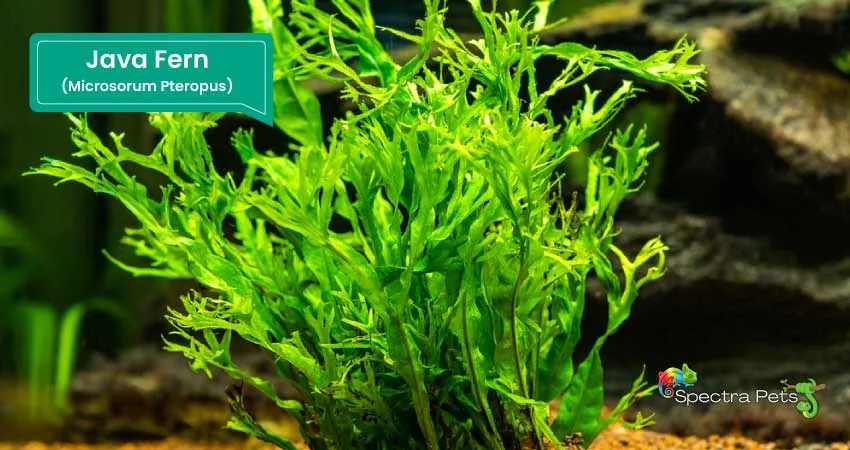
Quick Overview:
- Known for its low-maintenance care requirements.
- Tolerates a wide range of water conditions.
- The plant can thrive under low light.
- Its leaves provide good coverage and hiding spots for axolotls.
Let’s start with everyone’s favorite plant… that’s right- The Java fern! It’s hard to find a person in the US who hasn’t heard of these babies. They’re great to look at and make a great addition to any home. Guess what? You can also use them inside your axolotl tank.
You can attach them to the rocks or nearby decorations inside the tank. The best thing about them is that they need little care, so you don’t have to look out for them that much. Frankly, that’s a big advantage in my opinion because taking care of your axie will take a lot of attention.
Although you can neglect them to your heart’s content, sometimes do make sure whether your pet has eaten them or not. Because the frilly end is thick and gets stuck in their throats. You can easily take that part out, so not to worry.
For reasons unknown, few axolotls do seem to like dining on these plants. But that shouldn’t be much of a worry because it’s more of an exception than it is a pattern.
Java ferns can grow up to 10 inches. If you get a small tank, it will work just fine.
2. Amazon Swords (Echinodorus amazonicus)

Quick Overview:
- Amazon Sword is a hardy plant, ideal for the backdrop of a tank due to its size.
- It features broad leaves, which provide shelter for axolotls.
- Requires moderate lighting and nutrient-rich substrate for optimal growth.
Amazon swords! What a cool name, isn’t it? They look cool too…
They’re bright green and have leaves that look like actual blades. I wonder if it’ll cut my finger if I swipe across it? Let me know if any of you have done that. The leaves are also a great spot for your axolotl to hide and play around with. They provide shade too, no matter how you look at it- it’s perfect for an axolotl tank.
Although they prefer warmer climates, they can adjust themselves to fit colder temperatures too. You need to anchor them to the substrate. It grows up to 20″ tall and has a good width span.
3. Water Wisteria (Hygrophila difformis)
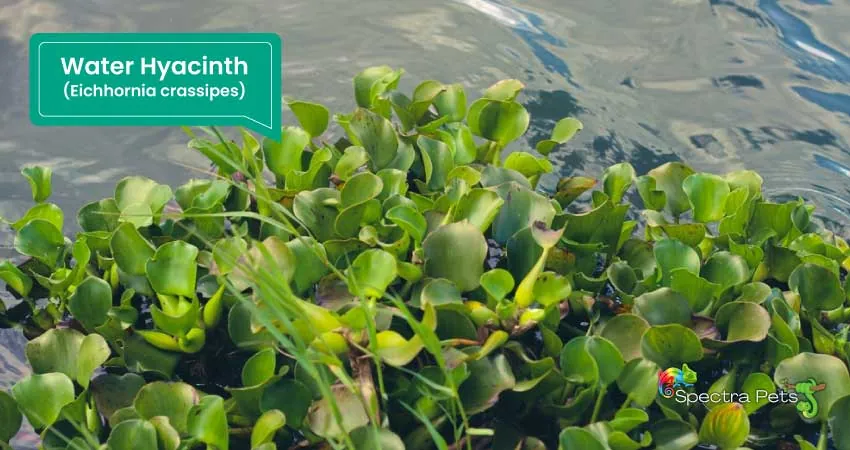
Quick Overview:
- Fast-growing plant, adaptable to a range of conditions.
- Provides good coverage, helping to make axolotls feel safe and secure.
- Requires moderate lighting and nutrient-rich substrate.
This one’s one of the most unique looking plants on this list. They have noticeable roots that will help you identify them, also their quirky leaves will make a great addition to any aquariums focusing on aesthetics.
I’ll give you two reasons for you to consider having it- it grows quickly, and doesn’t require much care. And, they’re pretty hard to kill, totally ideal for an axolotl tank.
But fast growing plants can easily clog the filter, so this is something you have to keep your eyes on. Weekly/monthly maintenance is a must. I can teach you another trick- put them on low light. They grow rapidly under bright conditions, so having low light will slow the growth.
Water wisteria can grow up to 2′ tall and 1′ wide, so only have it you have a big tank otherwise it’ll take over entirely.
4. Anubias (Anubias nana)
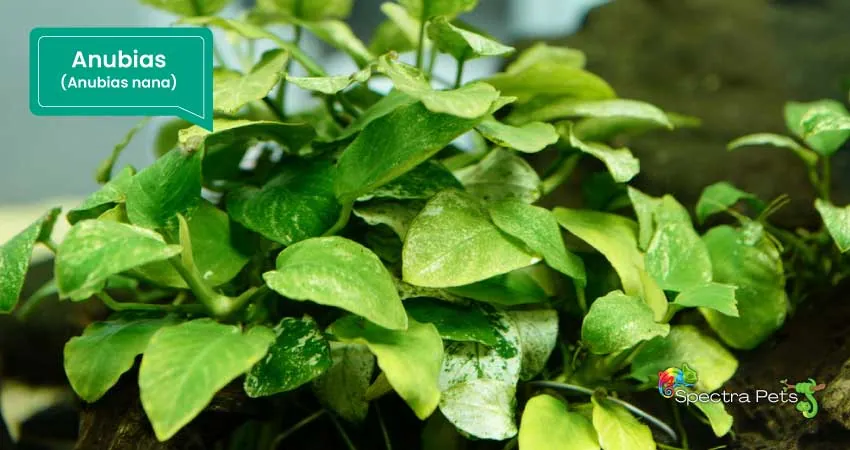
Quick Overview:
- Perfect for low-light conditions.
- It is a hardy plant that can be tied to driftwood or stones.
- Slow-growing and doesn’t need nutrient-rich substrate.
I’ll go straight to the reason why Anubias is a top pick for you- variety. Anubias have so many different features that you can have an entire tank full of these and to a normal person, it’ll look like an assortment of various plants.
They might look simple in terms of looks but when you’ll have so many different versions of Anubias in your tank, it’ll look as if you’ve simulated a real environment. I’m sure your axolotl would appreciate that.
These plants grow slowly, therefore they don’t need many nutrients and you won’t have to trim them regularly but on the flipside, they won’t filter water fast enough.
Also, it’s important for you to know that they can’t survive in a substrate, so for the best results, tie them to a rock. A fully mature Anubias is only 7.5″ tall.
There are 3 variations of anubis that are the best for axolotl or any other kind of tanks. They are: Anubias Nana, Anubias Isabelle and Anubias Barteri. Out of the three, Anubias Nana is the toughest.
5. Hornwort (Ceratophyllum demersum)
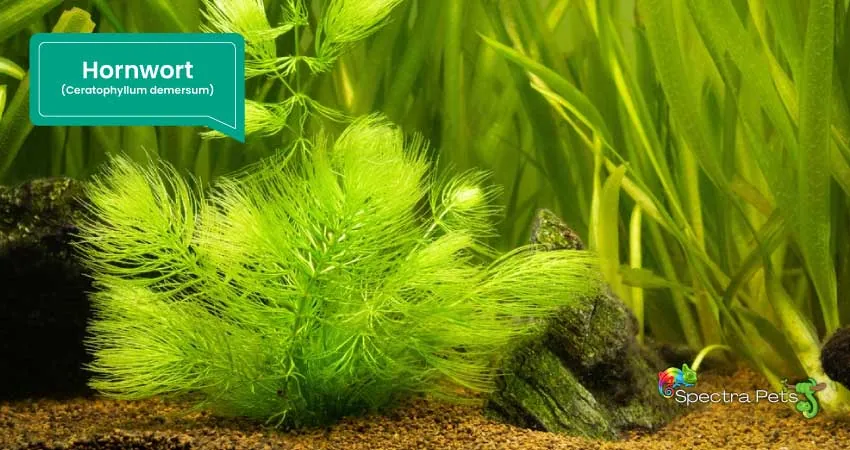
Quick Overview:
- Fast-growing plant that can float or be anchored.
- Tolerates a wide range of conditions.
- Provides excellent coverage and helps reduce nitrate levels.
Another great plant that I want to talk about is Hornwort. It is one of the fastest-growing plants you can have in your axolotl tank. And it’s personally one of my favorites as well due to how low-effort they are. Just throw them in and leave them there.
One of its coolest perks is that it can sustain the coldest temperatures without being affected [yes, that was a pun]. But if I had to speak of an issue it’d be that the plant does shed thorns. However, the shedding should be over in 2-4 weeks.
It can grow up to 10′ tall.
6. Marimo Moss Balls (Aegagropila linnaei)

Quick Overview:
- Unique spherical shape, a great addition for visual interest.
- Very low maintenance and slow-growing.
- Helps control algae by absorbing excess nutrients.
You might have heard of Marimo as an urban term Japanese kids use to tease one another, but these are actually tennis-sized balls of algae that you can use in your tank. They don’t even look like plants but work the same way they do.
I think they fit an aquatic tank perfectly. They’re amazing as decoration and your axolotl will like to play with them, rolling around with the ball-sized moss like a cat does with a wool ball. Since they grow slowly, you don’t have to maintain them too much and the substrate requirement is almost non-existent as well.
The most they can grow is 5-6″ in width, you can stuff your tank with 10s or 20s of them, and the most care you need to provide for them is to turn them around occasionally so they can soak in light.
Just one word of advice, add them to your tank only after they’re bigger than your pet’s head. Because for sure, your axolotl would like to eat it, but sadly it’d get stuck in its throat. Instead, have an auxiliary tank, let them grow, and then add them to the main tank.
7. Elodea (Elodea canadensis)

Quick Overview:
- Often used as an oxygenating plant.
- Fast-growing and can tolerate a wide range of conditions.
- It offers excellent cover for axolotls.
Elodea makes the list due to its credit of being one of the most easygoing plants for an axolotl tank. You’d be surprised to see how low-maintenance this plant is. It needs absolutely zero substrates, can grow practically in any space, and needs a minuscule amount of light while producing a lot of oxygen.
And you don’t have to worry about your axolotl eating these for lunch. However, you’re gonna need a medium-sized or a big tank to house these as they can grow up to 4′. You might wanna keep some time aside on the holidays to trim them a bit.
8. Pothos (Epipremnum aureum)
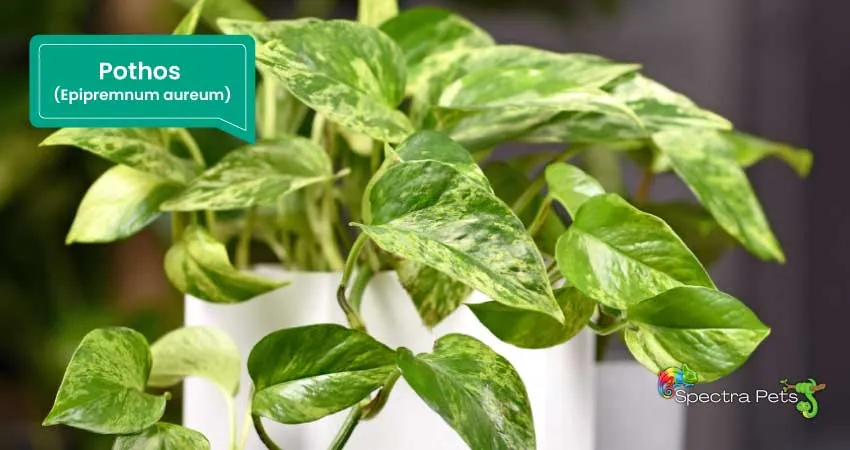
Quick Overview:
- Grown with roots in the water but leaves out of the water, perfect for absorbing nitrates.
- Very hardy and adaptable.
- It can thrive in low-light conditions.
Since axolotls spend the majority of their lives underwater and don’t live on land, they’ll eat and excrete inside the tank. For that reason, it’s a great idea to have a plant that works as a natural cleanser.
That’s where pothos came into play. These fellas don’t need much light and you can let them be as they are. You’ll need a good amount of vertical space as this plant can grow up to 30′, it’s HUGE!
The thing to look for is that the leaves should be out of the water and in the open, which means your tank needs to be positioned in such a way that there’s room for it over the water surface. You can leave the roots to be submerged as they’ll be in charge of all the filtering business.
It might sound like a lot of hassle to have one of these but trust me, when you’ll see how much nitrates it removes you’ll give yourself a pat on the back.
9. Water Lily (Nymphaea spp.)

Quick Overview:
- Surface-floating plant, providing shade and coverage.
- Requires moderate to high light.
- Can help reduce algae growth by limiting light penetration.
I don’t think you’ll find a single person who doesn’t know what a water lily is. These are one of the most beautiful aquatic plants out there. But I bet you’d be surprised if I tell you that you can put them in your axolotl tank as well! And you know what? They’d be great to look at.
Since they’re pretty big in size, you won’t need too many of them to decorate your tank. Plus, it’ll provide your tank with ample shade and clean out the toxin, all while producing beautiful flowers at the surface of the water. Speaking of flowers, they are fragrant, so you can be sure that your tank will be very pleasant.
You might think they don’t fit the vibe of an aquarium, but trust me and give it a shot.
10. Dwarf Hairgrass (Eleocharis parvula)
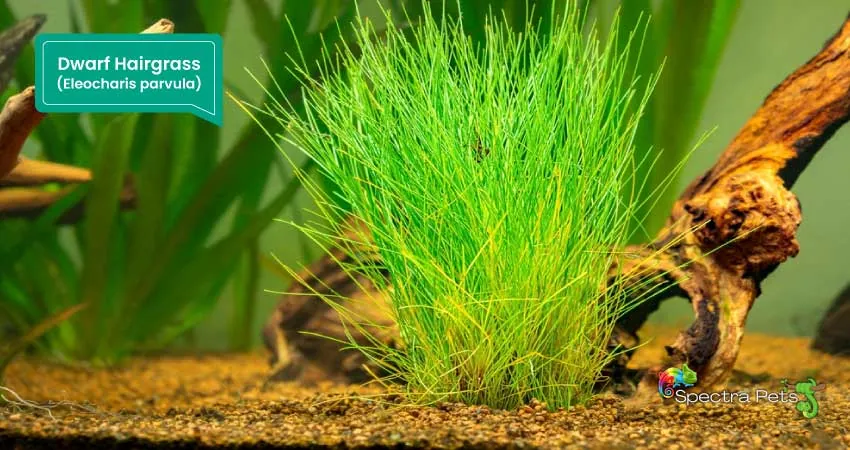
Quick Overview:
- Forms a grass-like carpet, excellent for axolotls to explore.
- Requires high light and CO2 to thrive.
- Provides a natural-looking ground cover.
One of the coolest things you could do with a plant would be to make a carpet of it on the bottom of an aquarium. And, a top pick for that is the Dwarf Hairgrass. Really, it looks like the Turf grass we see on football pitches.
They’re resilient and are low effort plants. You can have them in low light conditions and cool water doesn’t phase them. So, they’ll work perfectly in conditions where an axolotl would thrive.
Its growth is also not that rapid so you don’t have to worry about trimming. So, they’ll make a great plant carpet at the bottom of the tank. This will also make a good foraging spot for your axolotl.
Although it doesn’t make good hiding spaces, it’ll make a good playing ground for your axolotl.
11. Frogbit (Limnobium laevigatum)

Quick Overview:
- Floating plant with roots that provide cover and additional surface area for beneficial bacteria.
- Helps reduce light levels, which can deter algae growth.
- Requires little maintenance and is very adaptable.
Just like water lilies, frogbit is another plant that is gonna cover the entire upper surface of the axolotl tank. It’s one of the most popular plants amongst aquarists. It’ll grow aggressively and generate vertical leaves as it likes to keep them dry, which is the reason they float at the water’s surface.
Seriously, don’t underestimate its growth rate. It can single-handedly cover your entire tank’s top layer [the giant variant of this species can grow up to 20′]. Which is why I don’t think you should have another plant alongside it, especially if said plant is dependent on light, because frogbit will block out of it.
You will also have to trim it regularly to prevent overgrowth that might aesthetically ruin your tank’s look. But when you see how efficiently it filters out the ammonia, you’d be grateful.
12. Pennywort (Hydrocotyle leucocephala)
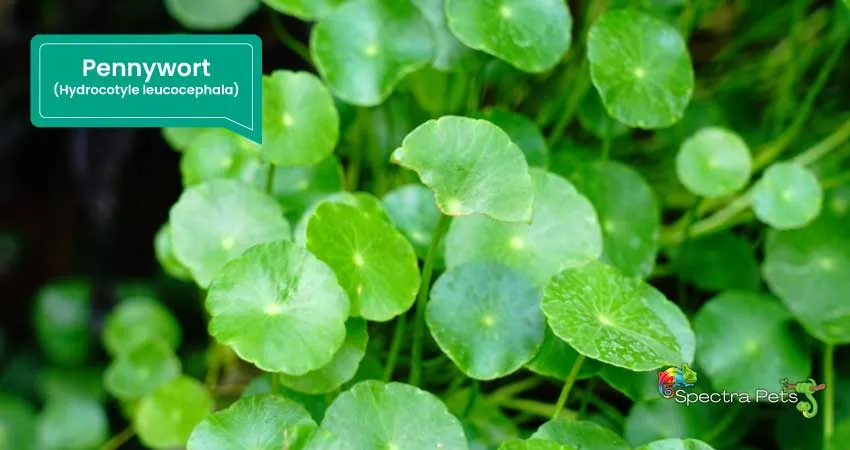
Quick Overview:
- Can be grown as a floating plant or rooted.
- Its leaves and stems provide excellent cover.
- Requires moderate light and nutrient-rich water.
If you want an aquarium that mimics the real aquatic environment then you must have a look at pennywort. Pennyworts, although labeled as plants for cold water, do better in 65 degrees F.
So there is a wide spectrum of temperature tolerance. However, it’s best if you don’t make your axolotl tank too warm because axolotl prefers temperatures below 64 degrees F. Have a look at my other article if you don’t know what’s the ideal temperature for an axolotl tank.
I need to warn you though, this is a plant that needs care, it can grow up to 2′ in height [width depends on the environment] pretty fast. So you’ll be ideally trimming them often.
It could either be planted in a substrate or you can let it roam freely on the surface of the water. I think you should let it float as it pleases.
13. Water Sprite (Ceratopteris thalictroides)

Quick Overview:
- Can be planted or left floating.
- Fast-growing and provides great coverage.
- Helps control nitrates and phosphates.
This one is another of my favorites. It’s one of the most popular plants for axolotl tanks, plus all others. You can find them in almost any kind of pet shop. The reason for its popularity is being beginner friendly. Plus, they act as a great filter.
It doesn’t need much maintenance, you can just let it be and propagate by itself. There’s no strict temperature demand either. You can plant it in the substrate or let it float, either way it’s fine.
One cool thing about it is that it’ll spread its shoots and that will propagate into a new plant. So you can get 2-3 more water spires for free! You can also artificially grow them by cutting them into pieces, kind of similar like grafting but without needing another plant; just leave it in the water.
This cute looking fern can grow up to 1′ in length and 8″ in width.
14. Brazilian Waterweed (Egeria densa)
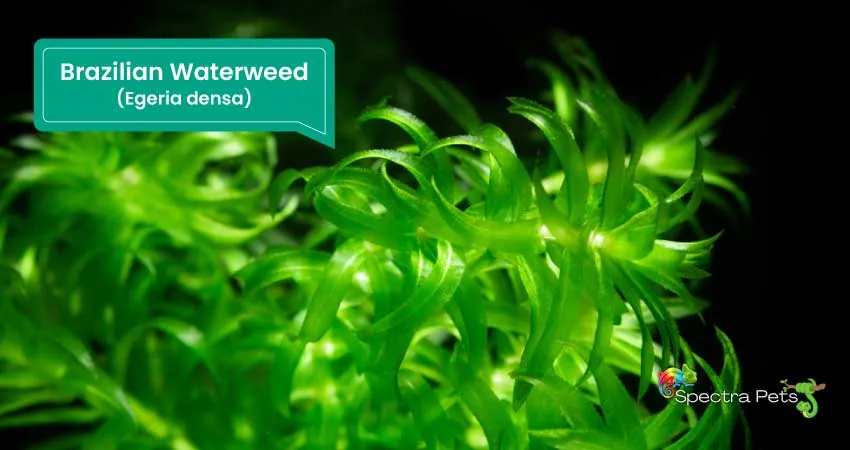
Quick Overview:
- Fast-growing, oxygenating plant.
- Can be planted or left floating.
- Provides good cover and helps control algae.
For beginner axolotl owners, there are hardly a few choices that are better than the Brazilian waterweed, a.k.a egeria densa. The reason I say this is because they grow quickly and without much effort.
It can grow up to 10″, but doesn’t spread out wide, so you don’t have any trimming duties. The nutrients from water is all that it needs to grow, which indirectly helps you halt algae growth without adding chemicals.
It grows rapidly in bright light, however low light conditions are completely fine, it won’t affect the health of the plant. The only effect will be a lighter tint and thinner twigs. You also require no substrate, however, you can plant it there should you prefer to.
I found out that it does best being tied to rocks, that way axolotls can’t uproot it. They’re also a great hiding place for your axie from sunlight.
15. Water Lettuce (Pistia stratiotes)
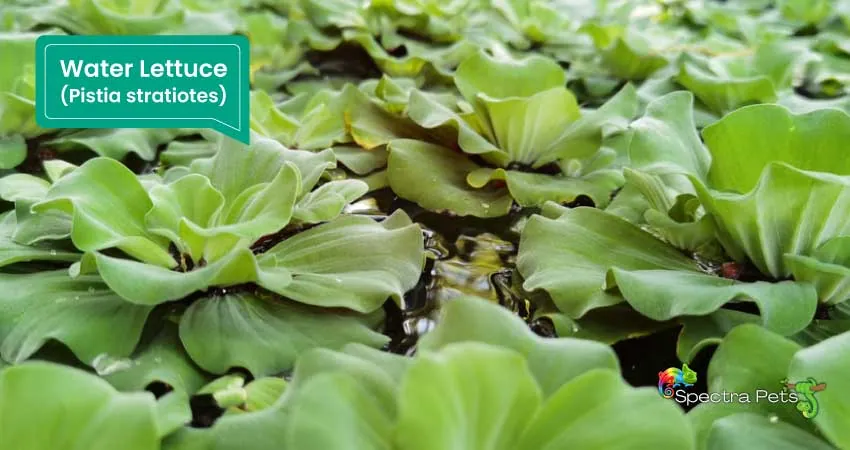
Quick Overview:
- Surface-floating plant that provides shade.
- Roots offer cover and breeding grounds for beneficial bacteria.
- Needs medium to high light.
This one is one of my favorite plants from the floating category. Because it’s got a pretty shape. A water lily might look the most fascinating, but a carpet of water lettuce just looks too cute. As if I’m looking at an army of small onions.
Just like Pothos, its roots will be submerged while its thick leaves stay on top of the water providing shade to your axolotl. Meanwhile, the root will get 2-3′ deep. The rosettes will grow 6″ in diameter.
Here’s a fun activity for you: try to make a maze out of the roots for an aesthetic appeal.
16. Duckweed (Lemna minor)
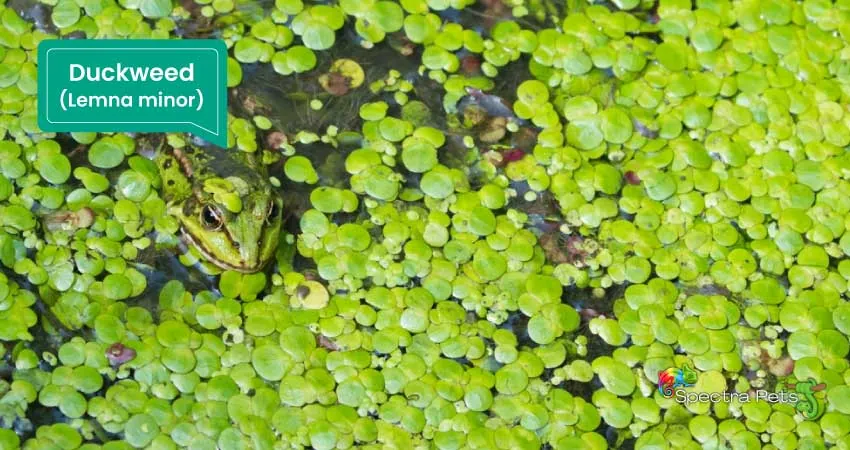
Quick Overview:
- Tiny floating plant that provides coverage and absorbs excess nutrients.
- Grows quickly and needs to be controlled to avoid covering the entire water surface.
- Very adaptable to a range of conditions.
Another great filter plant for your tank is the duckweed. It’s got tremendous multiplying ability, making it able to cover the entire upper surface of the tank at a short notice.
This way you can keep the light out naturally, and don’t even have to use a substrate. One more notable benefit of this plant is the temperature of the water below the surface stays cool thanks to its rapid multiplication.
If you’ve ever noticed any lake that apparently looks like it’s got a green carpet laid on top? Highly likely it’s full of duckweed.
But nothing is all perfect; having duckweed has its fair share of nuisances as well. You’ll spend a pretty good chunk of time scooping out the excessive plants otherwise it’ll take over the entire plant.
17. Floating Crystalwort (Riccia fluitans)
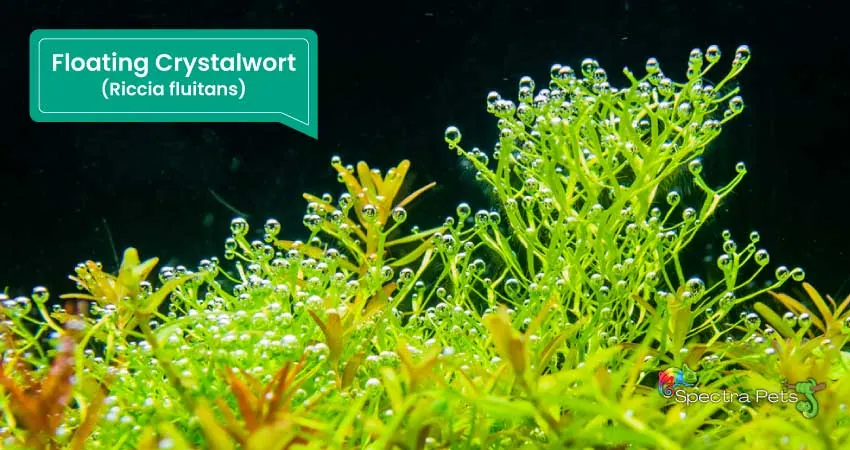
Quick Overview:
- Attractive floating plant or can be attached to surfaces.
- Helps control nitrates and provides cover.
- Needs moderate to high light and clean water.
You might want to give your tank a bushy look, like actual meadows. If that’s your goal then floating crystalwort is the one to go for. It’s an amazing low-effort plant that requires neither light nor substrate.
You can plant it in the lowest possible light and the coolest waters and yet it’ll grow beautifully, so it perfectly aligns with the kind of atmosphere Axolotls love.
If you get enough of them, you can make the entire bottom surface of the tank into a carpet of crystalworts. Whether you want to tie them to a rock or let them float is totally up to you, but personally I’d go with the idea of a carpet.
18. Banana Lily (Nymphoides aquatica)

Quick Overview:
- Unique looking plant with banana-like tubers at the base.
- Leaves can reach the surface, providing shade.
- Requires a nutrient-rich substrate.
Don’t be surprised, the Banana lily is an actual plant, and no it doesn’t look like a banana either. They got their names due to the fact that they can grow yellow tubers just like a banana.
These aquatic plants can love to be in cooler temperatures and are an ideal choice for both beginners and axolotl tanks.
To help these plants settle in, expose them to a lot of light. Then slowly turn down the exposure levels until they can settle in low light conditions.
They are able to grow up to 10′ and need a little substrate. You need to settle 1/4th of the roots in the substrate for it to grow in its full glory.
19. Water Hyacinth (Eichhornia crassipes)
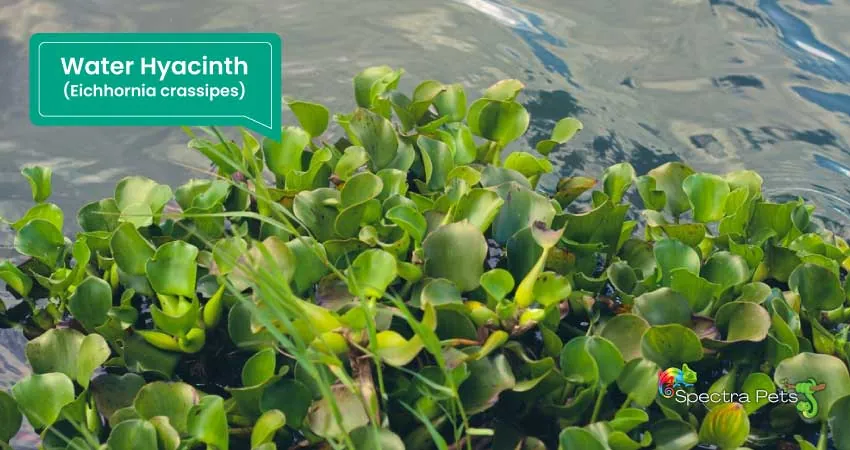
Quick Overview:
- Floating plant that provides excellent cover and shade.
- Rapid growth may require regular pruning.
- Needs high light and warm temperatures.
Hyacinths are one of the prettiest aquatic plants available on the planet, and I’m happy to inform you that they’re a possible candidate for your axolotl tank. Unlike most plants which are either green or sometimes yellow, this one grows a magnificent purple-colored flower when it’s matured.
You can let it float, they don’t require many substrates and are fairly easy to take care of. What you need to take care of is their rapid growth pattern. They can and will grow aggressively and take over your entire life if you let them be. So you need to keep an eye on that.
20. English Ivy Plant (Hedera helix)
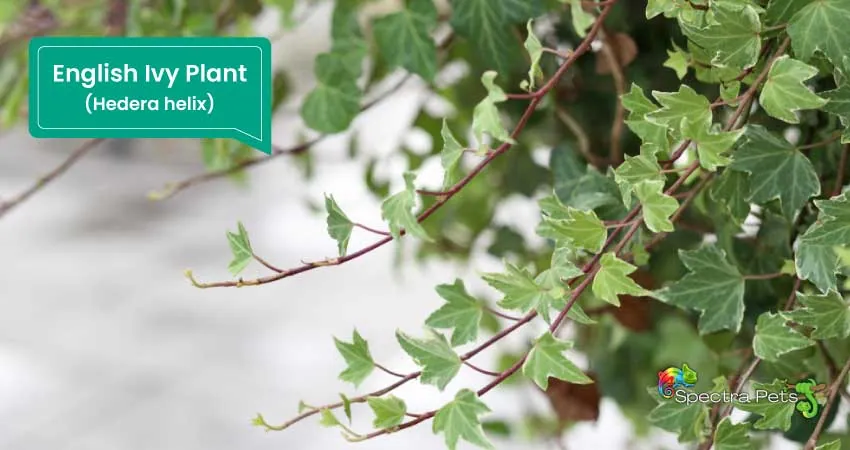
Quick Overview:
- Semi-aquatic, usually grown with leaves out of water and roots submerged.
- Helps absorb excess nutrients.
- Requires moderate light and is highly adaptable.
Another great-looking pick for the axolotl tank is the English Ivy Plant. You can let its root submerge in water as you let leaves hang outside the surface. I’d take caution if you place it with other plants due to its feisty growth rate that could phase out the other plants. But if you control it, it won’t serve as any nuisance.
But it’s also good at filtering, making the water quality of your tank quite fine. And, although people claim its growth will harm the animals, frankly speaking, I don’t see it being a problem for axies.
It’s a high-maintenance plant for sure, but the rewards are worth the pain you undergo.
Why are Live Plants Beneficial for Axolotls?
Initially, you might question the necessity of including live plants in an axolotl tank. After all, a tank equipped with a hiding spot and suitable substrate might seem sufficient. However, adding live plants to the mix introduces a myriad of benefits—from improving water quality to enhancing the tank’s aesthetics and creating a more natural environment for your axolotl.
Plants Positively Impact Water Quality
Plants serve as biological sponges within the aquatic environment, soaking up nitrates, ammonia, and other waste substances produced by the axolotl. By taking up these pollutants, plants act as natural filters, helping maintain the cleanliness and chemical balance of the water. This significantly reduces the frequency of water changes and prevents dangerous spikes in toxic substances.
A study published in the Journal of Aquatic Plant Management underscores the role of aquatic plants in improving water quality. The research notes that plants, through photosynthesis, enhance the oxygen levels within the tank—a factor of paramount importance for axolotls given their gill-breathing nature.
Plants Contribute to the Visual Appeal and Comfort of Axolotls
In terms of aesthetics, live plants introduce a refreshing verdancy to the aquarium, fostering a visually appealing and natural ambiance. They add dimension and depth to the tank, making it more than just a container of water and substrate but a miniature replica of axolotl’s natural habitat.
Moreover, for axolotls—creatures known for their sensitivity to light—plants provide much-needed shaded spots, reducing light intensity and offering comfort. They serve as objects of curiosity, encouraging exploratory behavior and mental stimulation. Additionally, the cover provided by plants can mimic natural hideouts, enhancing the axolotl’s sense of safety and security in its environment.
What Plant Attributes Should be Considered for an Axolotl Tank?
When it comes to plant selection for an axolotl tank, a range of factors merits consideration. The plant’s adaptability to axolotl-specific water and light conditions, its safety concerning potential toxicity, and its durability to withstand axolotl activity—these are the core attributes that will guide your choice.
Water and Light Conditions
Axolotls thrive in specific water conditions—temperatures between 60-64°F (15-18°C), pH levels of around 7.4-7.6, and low light levels. Therefore, the selected plants must be adaptable to these conditions. Submerged plants, like Java Fern or Anubias, which can tolerate a wide range of water parameters, are often a safe choice.
Moreover, considering axolotls are native to the remnants of Xochimilco, a system of lakes and canals near Mexico City, mimicking their natural habitat can significantly contribute to their overall well-being. A study in the Journal of Herpetology highlights the importance of replicating the natural environmental conditions for captive amphibians, including axolotls, for their optimal health and longevity.
Safe for Axolotls
Safety is a paramount factor when introducing any new element into an axolotl tank, and plants are no exception. Certain plant species can be toxic to axolotls or have sharp edges that might harm these delicate creatures. Therefore, it’s crucial to choose non-toxic plants and thoroughly rinse them to remove any potential pesticides or other harmful substances.
Furthermore, plants with large, soft leaves are often preferred. They not only provide a suitable hideout for axolotls but also prevent any accidental injuries. In contrast, plants with stiff or sharp leaves can pose a risk to axolotls and should be avoided.
Plant Durability
Axolotls, though seemingly gentle, are known to be quite active, particularly during the night. They have a habit of uprooting plants or damaging delicate ones during their explorations. Therefore, choosing sturdy, low-maintenance plants that can withstand axolotl activity becomes a prerequisite for a harmonious tank environment.
Java Ferns and Anubias are known for their robustness and low light requirements, making them an excellent choice for axolotl tanks. On the contrary, delicate plants like Cabomba or Dwarf Baby Tears might struggle to survive the axolotl’s nocturnal activities.
To put these attributes into perspective, here’s a table outlining the suitability of some popular aquatic plants for axolotl tanks.

Please note, these parameters are approximations and the plants’ adaptability may vary based on the specific conditions in your tank.
Can Artificial Plants be a Good Alternative for an Axolotl Tank?
Despite the numerous advantages of live plants, some axolotl keepers might still lean towards artificial ones due to their ease of maintenance and durability. Indeed, artificial plants can offer a blend of aesthetics and functionality while sidestepping some of the challenges posed by live plants. However, this decision is not without its considerations.
Pros and Cons of Using Artificial Plants
Artificial plants can indeed bring several advantages. Firstly, they require minimal maintenance compared to live plants, freeing you from concerns about appropriate lighting, potential plant diseases, or pruning needs. Their durability is also noteworthy—they won’t be uprooted or damaged by the axolotl’s activities, maintaining their appearance over time.
However, artificial plants miss out on the key biological benefits offered by live ones. They won’t contribute to water filtration or oxygenation, which can be particularly valuable in an axolotl tank. Additionally, some artificial plants may have sharp edges or may release harmful substances into the water over time, posing potential hazards for axolotls.
How to Choose and Install Artificial Plants?
If you decide to go the artificial route, take a few precautionary steps to ensure your axolotl’s safety. Firstly, choose artificial plants that are designed specifically for aquarium use. These are typically made from silk or soft plastic, reducing the risk of injury to axolotls.
When installing, make sure to secure the plants firmly to prevent them from being dislodged by the axolotl’s activities. Finally, remember to clean the artificial plants regularly, as they can become a breeding ground for algae and bacteria.
How to Troubleshoot Common Plant Problems in an Axolotl Tank?
Being proactive in identifying and resolving plant issues can maintain a healthy and stress-free environment for your axolotl. Algae overgrowth, leaf decay, slow plant growth, and plants uprooting are some common issues that might crop up.
Algae overgrowth, often caused by excessive light or over-fertilization, can be managed by adjusting light duration, cleaning the tank regularly, and using an algae scraper or brush for stubborn spots. Leaf decay can indicate poor water conditions or nutrient deficiencies, warranting water testing and possible addition of an axolotl-safe fertilizer.
If your plants aren’t growing well, check your lighting and nutrient levels. For plants being continually uprooted by your axolotl, consider using plant weights or attaching plants to tank décor.
The Bottom Line
Adding aquatic plants to your axolotl tank not only enhances its visual appeal, but also provides numerous benefits for your axolotl’s overall health and well-being. By incorporating the right plants into your tank, you can create a more natural environment that simulates their native habitat, helping to reduce stress and promote relaxation.
I have given you some amazing picks, you can create the perfect customized tank with them. So go ahead, do trial and error if necessary, and make your ideal axolotl tank.
